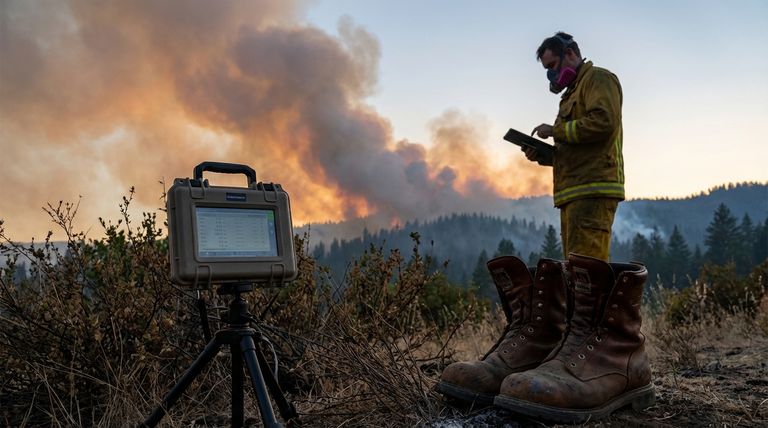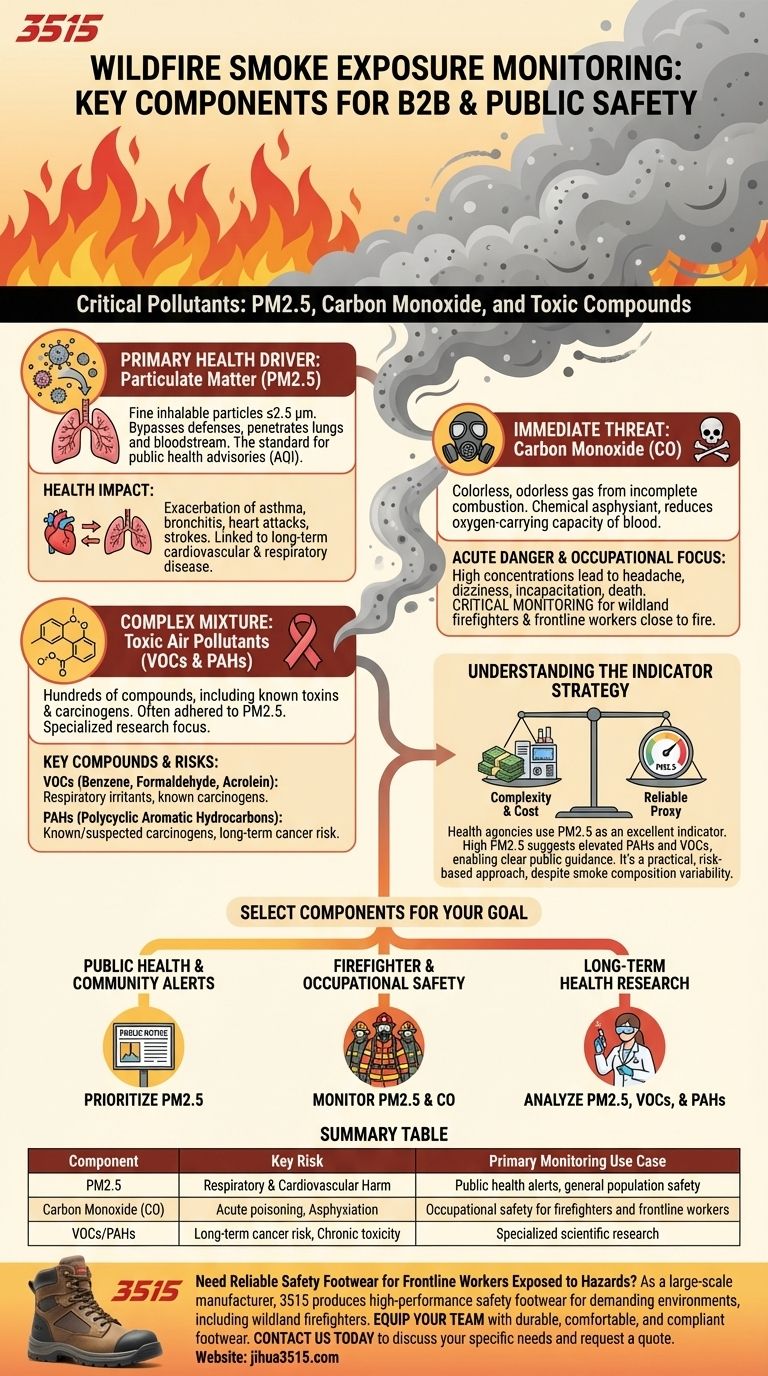When monitoring wildfire smoke exposure, the most critical components are particulate matter (especially PM2.5), carbon monoxide (CO), and a range of toxic air pollutants like volatile organic compounds (VOCs) and polycyclic aromatic hydrocarbons (PAHs). The specific combination of pollutants measured is determined by the monitoring goal, whether for public health alerts, occupational safety, or scientific research.
The core challenge in wildfire smoke monitoring is not identifying every compound, but selecting the right indicators for a specific risk. For the general public, PM2.5 is the single most important metric, while for frontline workers, carbon monoxide becomes equally critical.

The Primary Health Driver: Particulate Matter (PM)
Particulate matter is a complex mixture of solid particles and liquid droplets suspended in the air. In wildfire smoke, it is the component most directly linked to widespread public health impacts.
Why PM2.5 is the Standard
The designation PM2.5 refers to fine inhalable particles with diameters of 2.5 micrometers and smaller.
Because of their minuscule size, these particles can bypass the body's natural defenses, penetrating deep into the lungs and even entering the bloodstream.
This makes PM2.5 the most widely used and regulated indicator for smoke-related air quality, forming the basis for public health advisories like the Air Quality Index (AQI).
The Health Impact of PM2.5
Exposure to PM2.5 can cause a range of health issues, from short-term effects like eye and respiratory tract irritation to more severe outcomes.
These include exacerbation of asthma and bronchitis, heart attacks, and strokes. Chronic exposure is linked to long-term cardiovascular and respiratory diseases.
The Immediate Threat: Carbon Monoxide (CO)
Carbon monoxide is a colorless, odorless gas produced by incomplete combustion. It poses a different and more immediate risk than particulate matter.
A Focus on Acute Danger
CO is a chemical asphyxiant, meaning it reduces the oxygen-carrying capacity of the blood.
At high concentrations, CO can quickly lead to headache, dizziness, incapacitation, and death. This makes it a primary concern in situations with direct, nearby exposure to active burning.
The Target for Occupational Monitoring
Because CO concentrations dissipate rapidly with distance from the source, it is a less common metric for ambient, community-wide air monitoring.
However, for wildland firefighters and other personnel working close to a fire, monitoring CO is absolutely critical for preventing acute poisoning and ensuring immediate safety.
The Complex Mixture: Toxic Air Pollutants
Wildfire smoke contains hundreds of chemical compounds, including many known toxins and carcinogens. Monitoring these is typically reserved for specialized research applications.
Volatile Organic Compounds (VOCs)
VOCs are a group of carbon-based chemicals that are gaseous at room temperature. Key examples in smoke include benzene, formaldehyde, and acrolein.
These compounds are known respiratory irritants and, in the case of benzene and formaldehyde, are classified as carcinogens.
Polycyclic Aromatic Hydrocarbons (PAHs)
PAHs are formed during the incomplete burning of organic materials. They often adhere to the surface of PM2.5 particles, allowing them to be carried deep into the lungs.
Many PAHs are known or suspected carcinogens, making them a significant concern for understanding the long-term cancer risks associated with chronic smoke exposure.
Understanding the Trade-offs: The Indicator Strategy
It is not practical or cost-effective to measure every harmful component of smoke in real-time across a wide area. This reality leads to a practical, risk-based approach.
Complexity and Cost
Measuring specific VOCs and PAHs requires sophisticated and expensive laboratory equipment, such as gas chromatography-mass spectrometry.
This type of analysis cannot provide the immediate data needed for public health alerts or firefighter safety warnings.
PM2.5 as a Reliable Proxy
Health agencies operate on the principle that PM2.5 is an excellent indicator pollutant.
When PM2.5 levels are high, it is a reliable assumption that concentrations of other harmful components, like PAHs and VOCs, are also elevated. This allows for clear, actionable public guidance based on a single, easily measured metric.
The Limits of a Proxy
The exact chemical composition of smoke can vary significantly based on the type of fuel burning, the temperature of the fire, and weather conditions.
This means the toxicity of smoke at a given PM2.5 level is not always constant. However, for public protection, the indicator strategy remains the most effective and feasible approach.
How to Select Components for Your Goal
The right monitoring strategy depends entirely on your objective.
- If your primary focus is public health and community alerts: Prioritize measuring PM2.5, as it is the most reliable and widely understood indicator of overall smoke risk to the general population.
- If your primary focus is firefighter and occupational safety: Monitor for both PM2.5 for respiratory harm and Carbon Monoxide (CO) for the immediate risk of asphyxiation.
- If your primary focus is long-term health research: Conduct detailed chemical analysis of PM2.5, specific VOCs, and PAHs to understand the chronic toxicity of smoke.
Focusing on the right components for your specific goal ensures that your monitoring efforts are both effective and efficient.
Summary Table:
| Component | Key Risk | Primary Monitoring Use Case |
|---|---|---|
| PM2.5 | Respiratory & cardiovascular harm | Public health alerts, general population safety |
| Carbon Monoxide (CO) | Acute poisoning, asphyxiation | Occupational safety for firefighters and frontline workers |
| VOCs/PAHs | Long-term cancer risk, chronic toxicity | Specialized scientific research |
Need Reliable Safety Footwear for Frontline Workers Exposed to Hazards?
As a large-scale manufacturer, 3515 produces a comprehensive range of high-performance safety footwear and boots for distributors, brand owners, and bulk clients. Our production capabilities encompass all types of protective shoes designed for demanding environments, including those faced by wildland firefighters and emergency responders.
We can help you equip your team with durable, comfortable, and compliant footwear.
Contact us today to discuss your specific needs and request a quote.
Visual Guide
